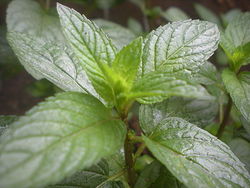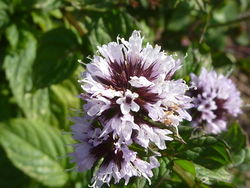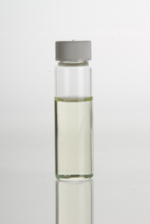Peppermint
| Peppermint |
|---|

|
| Scientific Classification |
|
| Binomial Name |
|
Mentha x piperita |
| A close up view of the peppermint plant's violet colored flower |
Peppermint is a hybrid herb known by the scientific name Mentha x piperita. It was created by combining two varieties of mint plants; which are spearmint and watermint. The plant was first defined by Carl Linnaeus in 1753. Peppermint is a green plant with violet purple flowers. Its green stem has a distinguishing square shape. The plant has reddish stems with a greenish purple coloring underneath leaves. The peppermint plant grows to the height of approximately 2 and half feet. It is a hardy plant that can survive freezing conditions. The peppermint plant enjoys full sun light, but it can also be planted in shady areas. It is a perennial plant, which means that it can live for more than 2 years. If conditions are favorable, the plant will return year after year. [2] [3]
Peppermint reproduces sexually and is pollinated by various insects including honey bees. It also has many different medicinal uses including aiding with nausea and the flu. God has created a beautiful and useful plant. "Using natural herbs is always a better and healthier way to go in regards to medicine and health". The plant can grow almost anywhere, because it's a hybrid. Peppermint also has certain invasive behaviors that can be threatening to a variety of areas. [4]
Body Design
Peppermint is an angiosperm that has many distinct and beautiful features. God has created such a unique and creative plant in nature. His glory is shown through all creation, but the design of the peppermint plant is definitely a masterpiece. This plant is most often seen in tea, because of this the plant seems small and dried. The peppermint plant can grow from 2 to 3 ft in height. It is a strong perennial and grows a hardy fibrous root system. The roots of the peppermint plant provide the plant with support, absorb water, and dissolve minerals for the plant. The roots contain root caps that push through the soil and are made up of dead cells. The roots of the peppermint plant are covered with small root hairs that help the plant to penetrate hard to reach water. The roots are a helpful part of the plant and do much behind the scenes underground. [5]
The stem of the peppermint plant supports the plant, displays the leaves, and conduct materials from the leaves that are used for photosynthesis. Photosynthesis is used to convert carbon dioxide into food for the plant. This plant has a green herbaceous dicot stem. The vascular tissues are arranged in fibrovascular bundles that are located on the edge of the stem. Attached to the stem are the peppermint plant’s dicot leaves, that absorb light and turn it into energy or food for the plant. The sun is the plants main energy source. The leaf has a blade which is their flattened part of the leaf. The blade is connected to the petiole, which connects the stem to the leaf. Peppermint plants have beautiful and shiny green leaves that are very well known. Peppermint has violet blossoms that bloom in late spring and early summer. The flowers produce great amounts nectar and attract honey bees. The peppermint plant has tall slender flowers with small violet buds around it. The flower is made up of the stamen, the ovule, the ovaries, and the petals. All are used in some way for reproduction. The flower is a very important part of the plant. Contrary to the strong smell of peppermint, the flowers have their own aroma. The flowers are not as commonly known as their leaves, but they still play a major part in the reproduction and in the characteristics of the plant. [6]
Life Cycle
The peppermint plant is a vascular, herbaceous, and a perennial plant. The plant’s life cycle includes various steps. Since the peppermint plant is a flowering plant, it reproduces sexually. The violet colored flowers are the main eye catcher of the plant. The petals are the beautiful part of the flower. Not only are they pretty, but they are responsible for attracting pollinators. The pollinators are attracted to the peppermints sweet smell and its violet color. The flower is made up of many unique parts, including the stamen and the pistil. The stamen is the male reproductive part of the flower. The stamen includes the anther, which holds the plants pollen grains. It is a characterized by its long and skinny filaments sprouting out on the sides of the pistol. The pistol is the female reproductive part of the peppermint plant. It holds the ovary and the ovule within the pistol of the plant. The stigma is where the pollen enters the ovaries. When fertilized, the ovule will develop into a seed. The pistol is characterized by its slender tip and wide base.[7]
When pollinators, like bees, land on the peppermint plant’s flower, it leaves small particles of pollen. The pollen will land on the tip of the stigma and forms a pollen tube. When the pollen tube reaches the ovary, the sperm from the pollen fuses with the egg cell. It then creates a zygote within the pistol. After being fertilized, the zygote develops into a seed and continues to grow. The seed is the beginning of each new plant. The peppermint plant reproduces in late spring and early summer. God created the peppermint plant to have a beautifully designed life cycle. It is amazing how one small plants can reproduce in such a unique and complex way.[8]
Ecology
The peppermint plant is a hybrid, so it produces no seeds and reproduces by spreading its rhizomes. Peppermint tends to prefer moist, damp habitats, including river and stream sides. Since peppermint is a hardy fibrous plant, it can grow just about anywhere and in any condition. It was first cultivated in 1750 near London, England. Naturally grown peppermint can be found almost anywhere. The plant likes full sunlight, but can still thrive well with partial light and in shaded areas with very little garden work. Peppermint is a plant that spread very invasively. The plant is invasive to the United States, Europe, and some parts of Australia. Since they are so invasive and will take over a garden, most people think it was wise to grow peppermint in a container. [9]
Peppermint plants are perennials, which means that they return yearly, its flowers grow in the late spring and early summer. Its food is nutrients that it absorbs from the soil and converts it into food. Its predators are Green mint beetles, Whiteflies, spider mites, aphids, and thrips. The plant also is known to repel flies and ants. Its smell is disliked to rats and mice, keeping them away. Insects are the main visitors to the peppermint plant. The insects are attracted to the plants sweet smelling nectar. [10]
Medicinal Uses
The peppermint plant has many beneficial factors involved with it. One of those main factors is its medicinal uses. Peppermint is an herb that is very helpful and simple to use. Peppermint is a stimulant and a relaxant. It relaxes by soothing a person’s nerves and it stimulates the circulatory system. Peppermint oil and tea are both beneficial, but the oil has more stimulating qualities. Peppermint has been known to help treat muscle spasms. The oil can be used to sooth a painful headache when applied to a person’s forehead. Many experiments took place in Britain and Germany to help prove this theory. The peppermint plant can also be used to aid in digestion and indigestion. It does this by increasing the digestive juices in the stomach thus reliving the uneasiness. It also helps by relaxing the main muscle in the digestive track. Peppermint can also be a treatment for nausea as well. [11]
Peppermint is able to aid a cold and the flu along with the symptoms that apply to them. Peppermint is a decongestant and helps to improve breathing when influenced by one of these illnesses. Along with the flu, peppermint may help with chills and the lowering of a fever. Peppermint oil can be used on skin as a moisturizer and helps to relive itchiness. Since peppermint has such a strong smell, some insects including mosquitoes will stay away from it. Because of this it can be used as an all natural mosquito repellent. Although peppermint is a safe plant, there are a few rare side effects. Including taking too much peppermint oil with sugar for too long, it may cause stomach irritation. It may also in a rare case cause diarrhea.[12]
Video
A close up view and medicinal purposes of peppermint
References
- ↑ Unknown, Author. Mentha x piperita L. peppermint.USDA. Web. 26, May, 2015.
- ↑ Kristen, Keith. Mentha x piperita.Keith Kristen’s Plant Info. Web. 26, May, 2015.
- ↑ Unknown, Author. Peppermint.Wikipedia. Web. 26, May, 2015.
- ↑ Schwoppe, Cornelia. Peppermint.Kooperation Phytopharmaka. Web. 26, May, 2015.
- ↑ Sharpe, Kimberly. Information About the Peppermint Plant.Garden Guides. Web. 18-May-2015.
- ↑ Rubel, Lori. 3 Plants Peppermint Mentha piperita M. balsamea Willd.Gerorgia Vines.Web. 18-May-2015.
- ↑ Dick, Blue. Herbaceous Perennial Life Cycle. Herbaceous Plants .Web. 26, May, 2015.
- ↑ Unknown, Author. Peppermint. Folia .Web. 26, May, 2015.
- ↑ Rhoades, Jackie. Peppermint Planting: Growing Peppermint And How To Use Peppermint Plant.Gardening Know How. Web. 18-May-2015.
- ↑ Alfrey, Paul. Peppermint- Mentha x piperita.Balkep balken ecology project. Web. 18-May-2015.
- ↑ Ransom, Susie. Peppermint.Dr. Christopher’s Herbal Legacy.Web. 26, May, 2015.
- ↑ Ratini, Melinda.Peppermint oil.WebMD.Web.26, May, 2015.



